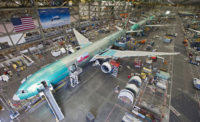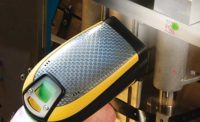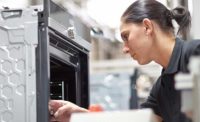Those of us who have been long-time football fans recall years ago seeing coaching staff treading the sidelines holding clipboards with sheets of paper flapping in the breeze. As players came back to the bench, the coaches would scribble out plays or flip through play sheets to diagnose what just happened out on the field.
Things have moved along. Now, the TV camera picks up the players huddled around their blue Microsoft tablets. For the minute or two they have on the bench, the team is watching video of the last play to figure out what to do better, isolating a weakness of the opponent, or figuring out how to keep on doing what just worked.
Of course, a football stadium is not an office. The weather abuses these tablets, and they sure aren’t coddled by the players. But, are these devices tough enough to go from the sideline to the assembly line? Hardly.
Though many assembly operations approach clean room conditions, most are not. Tablets and touch screen computers must withstand dusty environments, temperature extremes and moisture. Additionally, while a sideline computer might get used for three or four hours on game day, a shop floor computer is expected to run at least eight hours a day and five days a week. It might even have to run 24/7.
Assembly operations have been using mobile and mounted touch screen devices throughout this century to control their processes, stay on top of workflows, and collect data. Nevertheless, there are still many companies that have yet to take advantage of this technology.
Computers on the Line?
Integrating computers into the assembly process offers many benefits. Operations can do a better job monitoring the process up and down the line. Better communications enables line workers to determine when the process needs to slow down because of bottlenecks downline or when they can kick up production speed.
Aside from the action on the line, manufacturing management is hungry for data. Mobile computers and touch screens enable operations to harvest information for better control, analysis of weaknesses, and traceability of critical parts. These are the tools for forecasting and capacity scheduling.
Capturing data using industrial-rugged computers means it is readily available on the system. That is why assembly operations are ditching paper, pens and clipboards, which can lead to errors as the person entering data tries to decipher someone else’s handwriting.
Touch screens on the assembly line enable faster and reliable training of workers. These windows into the system facilitate a human-machine-interface that goes beyond just data acquisition.
While a growing number of assembly operations are using mobile computers and touch screens, the question is, when should a growing company bring this technology online? As with any operation, engineers must make a case to management to bring a new technology, like mobile computers, into the plant. This is especially true for newer companies, which are more inclined to justify technology investments as they grow and can afford it.
If you’re considering industrial-rugged computers for your operation, here’s what you should know. First, three kinds of computing devices are used on the plant floor:
Mobile tablets. These are ideal for technicians and management who are operating on the fly. Having the plant’s enterprise resource planning system (ERP) at their fingertips means they can enter their evaluations on equipment and inventory status on the spot and up to the minute.
Stationary touch screens. These computing devices need to stay put along the line to handle largely repetitive operations and to perform other tasks. Technicians can monitor product flow, accumulate data on the process, communicate along the line in case slowdowns occur, and control the operation of assembly systems. Meanwhile, workers along the line have an idea of what is coming down the line.
Mobile workstations. In this case, tablets or touch screens are mounted to wheeled carts to manage functions related to assembly yet are done off the line. These carts make technicians more efficient, saving steps by bringing these computing devices to the work. Plants typically use these carts for quality assurance, inspection and packaging-related activities, such as printing labels. As with mobile tablets, workstation-mounted touch screens reduce paperwork.
Hardware Fit for the Plant Floor
On the factory floor, tablets and touch screens can be integrated into manufacturing lines and machine arms, attached to forklift cages, and included on mobile carts. For the most part, assembly operations use these devices in dirty, dusty working conditions and areas with temperature extremes.
For extreme temperatures, some industrial-grade computing devices have a fanless, heatsink design. These units protect their internal components from particle intake while dissipating heat. They are capable of handling wide temperature ranges and can be taken out into the yard or used next to heat-generating machinery.
The two factors crucial for a tablet or touch screen PC on the factory floor are readability and responsiveness. The lighting on factory floors can range from dim to extremely bright.
There are three major screen technologies: LCD-lit screens, thin-film transistor screens, cold cathode fluorescent lamp backlit screens. Consider units that offer high resolution and high brightness. Screens should be readable in sunlight and offer a wide viewing angle. Readability is crucial because information must be viewed off the screen quickly, and any miscomprehension can lead to severe consequences.
The demands of industrial applications require screens with a useful life of 100 million touches. Many industrial operations, particularly maintenance, electrical wiring or wash-downs, require protected hands, and the resistive screens can be responsive to touch even when fingers are protected by work gloves. Resistive touch technology is a pressure-based system that works with any touch, whether that be bare fingers, gloves, or a random object like a pencil or tool.
For computing devices not attached to the line, portability doesn’t just mean the ability to operate without being plugged in. These units have to withstand the rough industrial environment. On the factory floor, this handling includes the occasional drop onto a concrete floor, which can put a consumer-grade computer out of operation. Industrial grade computers can withstand these impacts and remain on the job.
Computing Advancements
Wireless technology has empowered technicians, assemblers and managers to roam the plant floor with their mobile devices. This design makes it easy for printers, bar code scanners, and test equipment to be located wherever they’re needed on the assembly line.
Stationary touch screens also benefit from wireless technology, allowing management to reconfigure the line for changes in product design, mix or volume. Mesh technology and range extenders are enabling plants to take advantage of their computers’ wireless features.
The Android Operating System isn’t just for smartphones. Thanks to the flexibility offered by this operating system, mobile computers will function successfully with a variety of ERP systems.
Android provides the flexibility that evolving manufacturers need. Computing devices, particularly mobile computers, are versatile, and Android makes them even more desirable, as developers can easily customize applications to accommodate unique I/O devices and create graphical user interfaces to manage any industrial use.
Android industrial computers do not require the additional storage capacity and memory requirements that are necessary for Window-based computers. That makes them more affordable for use in factory automation systems.
Size matters. In an assembly plant, smaller means tougher. We know from experience that computing tablets get dropped all the time. That’s often the reason for the short life span for consumer-grade tablets.
Smaller computers are better able to survive drops to the floor. Thanks to smaller components, compact size and harder cases, these units are ready to go no matter where they go. Plus, these computers are easier to carry and, when mounted, take up less room on the line or the cart.
Tools for Production
Information is the key to productive assembly and the means for operational improvements and waste reduction. Assemblers and managers will glance at these rugged PCs thousands of times a day, so it pays to invest in quality products. These devices serve as a window into the performance of their systems and equipment.
Downtime is deadly. Industrial-rugged computers are rigorously tested to ensure that they can handle extremes.
Since no manufacturing or processing environment is created equal, be sure your supplier can provide you with a device that meets the specific demands of your operation and can achieve your goals of monitoring and controlling your systems. The right computer will provide your factory with years, rather than months, of service and enable your assembly line to be part of the smart manufacturing movement.
For more information, call Teguar at 877-870-3377 or visit https://teguar.com.








